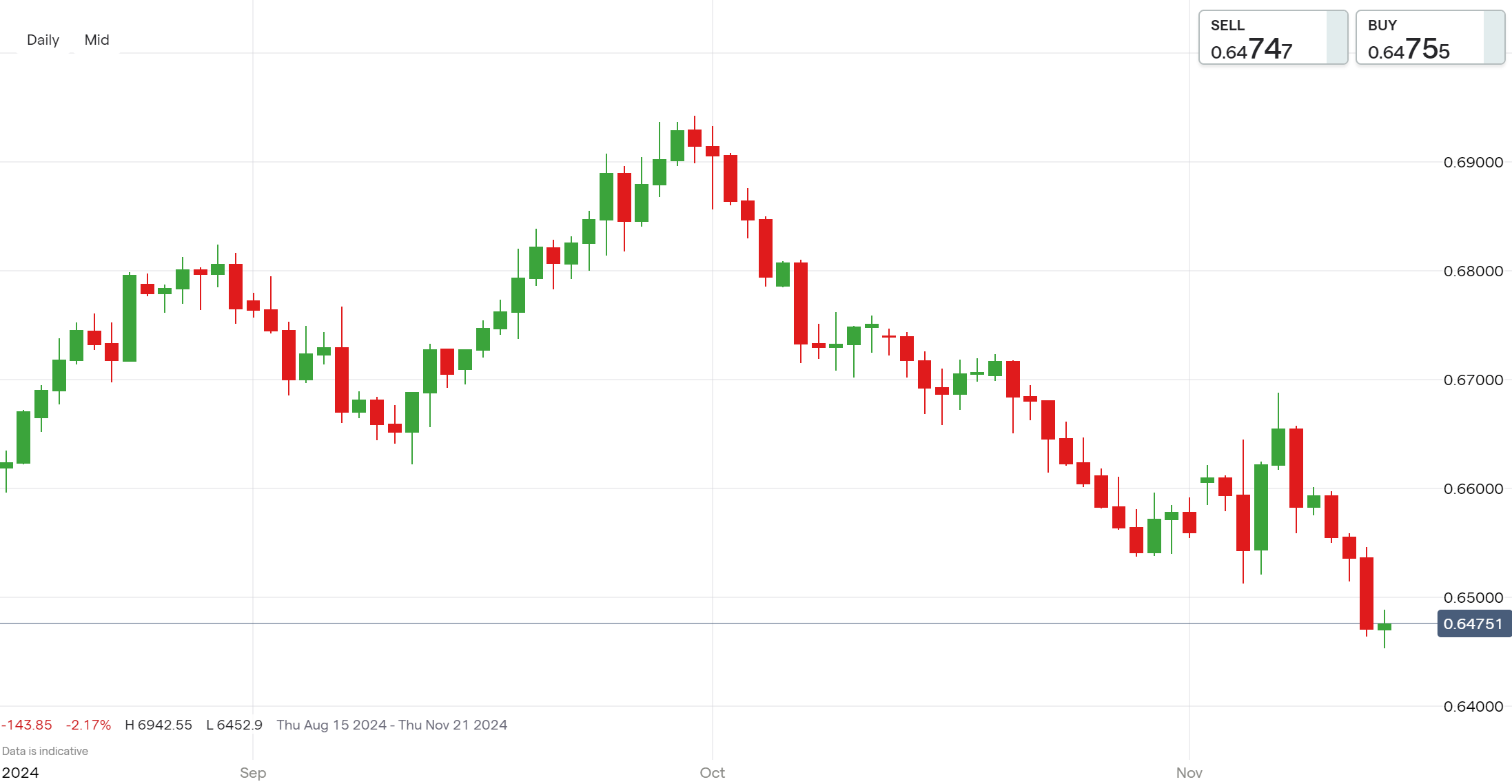AUD/USD falls below 0.65000 amid RBA policy and strong USD dynamics
AUD/USD dips below 0.65000 as RBA maintains current policy amid slow job growth, while a robust US dollar faces potential shifts from Fed rate cuts and fiscal changes. Watch for evolving monetary strategies.

Key points
- AUD/USD drops to 0.64529, its lowest in three months
- US dollar index rises to 106.4 post-election, strengthening across currencies
- RBA holds interest rate at 4.35% amidst mixed employment data
- Fed's anticipated rate cuts could affect dollar's appeal
- Traders should monitor RBA and Fed strategies for impact on AUD/USD
AUD/USD sinks below 0.65000
Despite its brief recovery the first week of November, the aussie has continued its bearish trend against the US dollar, hitting 0.64529 per USD this morning. This hovers around its lowest level in three months as Reserve Bank of Australia (RBA) monetary policy outlook remains consistent with its current status. This aussie weakness also stems from the US dollar’s strength, and potential trade relation concerns though incumbent US President Donald Trump’s trade policies and ideals.
AUD/USD price history

US DXY maintains highs amid economic data releases
The US dollar index floats at around 106.4, reflecting bullish gains after last week’s Trump election victory. Trump policies are focused heavily on trade tariffs with other countries, leading to the dollar’s strength against most currencies. Meanwhile, the Federal Reserve announced a cautious 25 basis point (bps) rate cut last Thursday, balancing inflation concerns with a weakening labor market. Another similar rate cut is anticipated in December. This situation could weaken the dollar as political and fiscal uncertainties, combined with expected interest rate cuts, may reduce its appeal to investors seeking stable returns. Lower interest rates typically make a currency less attractive, potentially leading to further depreciation if economic conditions don't improve or if fiscal policies shift significantly. Furthermore, annual US inflation rose to 2.6% this October, a 0.2% increase from September, and core inflation remained at 3.3%. Also on the economic calendar, consumer price index (CPI) increased by 0.2%, and analysts await Fed Chair Powell’s remarks and retail sales data on Friday.
RBA financial outlook remains mixed upon employment data release
Australia's employment report release for October reported a stable unemployment rate at 4.1% for the third month in a row. This consistency suggests that, while the labor market is not worsening, it may not be improving at the pace economists anticipated. The job growth of 15,900 falls significantly short of the forecasted increase of 25,000 jobs, indicating potential headwinds in the nation's economic recovery or challenges in sectors expected to drive employment gains. This shortfall could reflect issues such as slower business investment, sector-specific struggles, or external economic pressures that are dampening job creation.
In response to these economic indicators, Reserve Bank of Australia (RBA) Governor Michele Bullock articulated the bank's current monetary policy stance, affirming that interest rates will remain at 4.35% until there is clear evidence that inflation is under control. This stance highlights the RBA's cautious approach, balancing the need to support economic growth with the imperative to manage inflationary pressures. The decision to hold interest rates steady suggests that the RBA is closely monitoring economic indicators, particularly inflation, as it seeks to foster an environment conducive to sustainable growth without exacerbating inflation.
Governor Bullock's commitment to maintaining current interest rates underscores the central bank's focus on achieving price stability before considering rate adjustments. This policy approach aims to provide certainty and stability to businesses and consumers, allowing them to plan and invest with confidence. The employment data and RBA's monetary policy signals will be key points of focus for investors, policymakers, and economists as they assess Australia's economic trajectory and the potential timing of future interest rate changes.
What’s next for AUD/USD?
The AUD/USD pair has reflected a continued bearish trend for the Australian dollar against the US dollar. Despite the US dollar's current robustness, driven by trade tariff policies, there are potential vulnerabilities due to anticipated interest rate cuts by the Federal Reserve, which could reduce the dollar's attractiveness if fiscal policies shift significantly or economic conditions fail to improve.
For the Australian dollar, the recent employment data showing stable yet uninspiring job growth could weigh on investor sentiment. The RBA’s commitment to maintaining a target range 4.35% interest rate until inflation is under control suggests a cautious outlook that might not immediately support the AUD in the short term. The lag in expected job growth and concerns over business investment, along with its trade relationship with China, may keep pressure on the Australian economy, potentially limiting any significant recovery for the Aussie in the near term.
Looking ahead, the AUD/USD pair's future direction will hinge on several factors. The RBA's monetary policy stance and Australia's economic indicators, particularly inflation and employment data, will play crucial roles. Meanwhile, shifts in US fiscal and monetary policy, influenced by Fed Chair Powell's upcoming remarks and retail sales data, could impact the US dollar's strength. Traders should watch these developments closely, as they will be key in determining the pair's trajectory, with potential for volatility depending on policy adjustments and economic conditions in both countries
More where that came from: check out what’s new in forex today on our YouTube channel:
How to Trade AUD/USD
- Open an account to get started, or practice on a demo account
- Choose your forex trading platform
- Open, monitor, and close positions on AUD/USD
Trading forex requires an account with a forex provider like tastyfx. Many traders also watch major forex pairs like EUR/USD and USD/JPY for potential opportunities based on economic events such as inflation releases or interest rate decisions. Economic events can produce more volatility for forex pairs, which can mean greater potential profits and losses as risks can increase at these times.
You can help develop your forex trading strategies using resources like tastyfx’s YouTube channel. Our curated playlists can help you stay up to date on current markets and understanding key terms. Once your strategy is developed, you can follow the above steps to opening an account and getting started trading forex.
Your profit or loss is calculated according to your full position size. Leverage will magnify both your profits and losses. It’s important to manage your risks carefully as losses can exceed your deposit. Ensure you understand the risks and benefits associated with trading leveraged products before you start trading with them. Trade using money you’re comfortable losing. Past performance is not indicative of future results.
